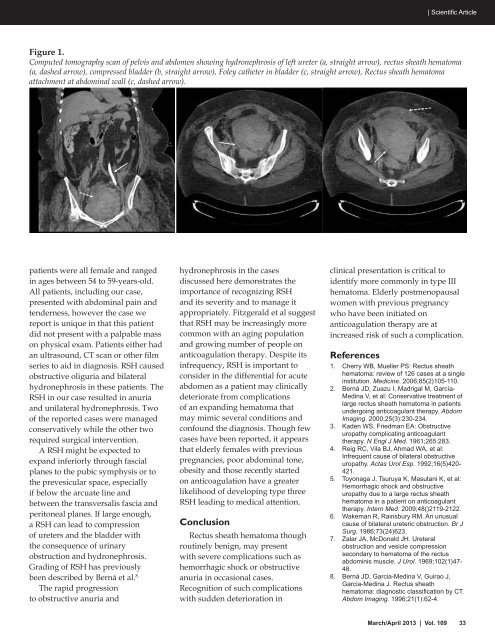March/April - West Virginia State Medical Association
March/April - West Virginia State Medical Association
March/April - West Virginia State Medical Association
You also want an ePaper? Increase the reach of your titles
YUMPU automatically turns print PDFs into web optimized ePapers that Google loves.
| Scientific Article<br />
Figure 1.<br />
Computed tomography scan of pelvis and abdomen showing hydronephrosis of left ureter (a, straight arrow), rectus sheath hematoma<br />
(a, dashed arrow), compressed bladder (b, straight arrow), Foley catheter in bladder (c, straight arrow), Rectus sheath hematoma<br />
attachment at abdominal wall (c, dashed arrow).<br />
patients were all female and ranged<br />
in ages between 54 to 59-years-old.<br />
All patients, including our case,<br />
presented with abdominal pain and<br />
tenderness, however the case we<br />
report is unique in that this patient<br />
did not present with a palpable mass<br />
on physical exam. Patients either had<br />
an ultrasound, CT scan or other film<br />
series to aid in diagnosis. RSH caused<br />
obstructive oliguria and bilateral<br />
hydronephrosis in these patients. The<br />
RSH in our case resulted in anuria<br />
and unilateral hydronephrosis. Two<br />
of the reported cases were managed<br />
conservatively while the other two<br />
required surgical intervention.<br />
A RSH might be expected to<br />
expand inferiorly through fascial<br />
planes to the pubic symphysis or to<br />
the prevesicular space, especially<br />
if below the arcuate line and<br />
between the transversalis fascia and<br />
peritoneal planes. If large enough,<br />
a RSH can lead to compression<br />
of ureters and the bladder with<br />
the consequence of urinary<br />
obstruction and hydronephrosis.<br />
Grading of RSH has previously<br />
been described by Berná et al. 8<br />
The rapid progression<br />
to obstructive anuria and<br />
hydronephrosis in the cases<br />
discussed here demonstrates the<br />
importance of recognizing RSH<br />
and its severity and to manage it<br />
appropriately. Fitzgerald et al suggest<br />
that RSH may be increasingly more<br />
common with an aging population<br />
and growing number of people on<br />
anticoagulation therapy. Despite its<br />
infrequency, RSH is important to<br />
consider in the differential for acute<br />
abdomen as a patient may clinically<br />
deteriorate from complications<br />
of an expanding hematoma that<br />
may mimic several conditions and<br />
confound the diagnosis. Though few<br />
cases have been reported, it appears<br />
that elderly females with previous<br />
pregnancies, poor abdominal tone,<br />
obesity and those recently started<br />
on anticoagulation have a greater<br />
likelihood of developing type three<br />
RSH leading to medical attention.<br />
Conclusion<br />
Rectus sheath hematoma though<br />
routinely benign, may present<br />
with severe complications such as<br />
hemorrhagic shock or obstructive<br />
anuria in occasional cases.<br />
Recognition of such complications<br />
with sudden deterioration in<br />
clinical presentation is critical to<br />
identify more commonly in type III<br />
hematoma. Elderly postmenopausal<br />
women with previous pregnancy<br />
who have been initiated on<br />
anticoagulation therapy are at<br />
increased risk of such a complication.<br />
References<br />
1. Cherry WB, Mueller PS: Rectus sheath<br />
hematoma: review of 126 cases at a single<br />
institution. Medicine. 2006;85(2)105-110.<br />
2. Berná JD, Zuazu I, Madrigal M, García-<br />
Medina V, et al: Conservative treatment of<br />
large rectus sheath hematoma in patients<br />
undergoing anticoagulant therapy. Abdom<br />
Imaging. 2000;25(3):230-234.<br />
3. Kaden WS, Friedman EA: Obstructive<br />
uropathy complicating anticoagulant<br />
therapy. N Engl J Med. 1961;265:283.<br />
4. Reig RC, Vila BJ, Ahmad WA, et al:<br />
Infrequent cause of bilateral obstructive<br />
uropathy. Actas Urol Esp. 1992;16(5)420-<br />
421.<br />
5. Toyonaga J, Tsuruya K, Masutani K, et al:<br />
Hemorrhagic shock and obstructive<br />
uropathy due to a large rectus sheath<br />
hematoma in a patient on anticoagulant<br />
therapy. Intern Med. 2009;48()2119-2122.<br />
6. Wakeman R, Rainsbury RM. An unusual<br />
cause of bilateral ureteric obstruction. Br J<br />
Surg. 1986;73(24)623.<br />
7. Zalar JA, McDonald JH. Ureteral<br />
obstruction and vesicle compression<br />
secondary to hematoma of the rectus<br />
abdominis muscle. J Urol. 1969;102(1)47-<br />
48.<br />
8. Berná JD, Garcia-Medina V, Guirao J,<br />
Garcia-Medina J. Rectus sheath<br />
hematoma: diagnostic classification by CT.<br />
Abdom Imaging. 1996;21(1):62-4.<br />
<strong>March</strong>/<strong>April</strong> 2013 | Vol. 109 33















